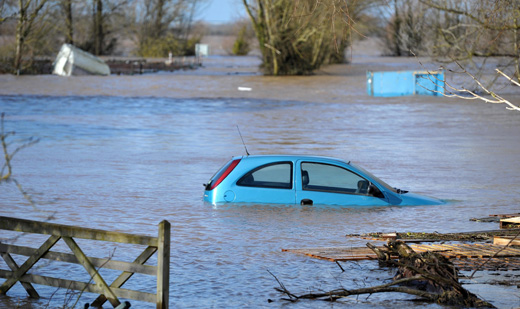
LONDON – At long last the army has arrived on the Somerset Levels (a coastal area in South West England) where floodwaters have been disrupting normal life since just after Christmas.
The army is using amphibious vehicles to deliver sandbags, fuel, food, and water to villages like Mucheleny and Thorney that have been cut off for weeks with access only by small boat.
The army is also transporting local people to check on long-flooded and deserted remote farms, villages and isolated dwellings.
Now the army vehicles will also give some reassurance to older residents who fear a medical emergency and the impossibility of getting a doctor or to hospital.
Local residents are, of course, delighted with the arrival of the troops.
But they are angry with just how long it has taken for Prime Minister David Cameron, Deputy Prime Minister Nick Clegg and Environment Minister Owen Paterson to pay any attention to the month-old floods.
Patterson finally showed himself in the Levels last Monday, just after the delivery of some shiny new pumps. The pumps made a good background to the TV shots.
The visit was also just after the local Tory-controlled Somerset County Council embarrassed the Conservative/Liberal Democrat government by declaring the floods a “major incident” and a state of emergency.
On his visit the minister was visibly shocked by the anger from locals against the government’s lack of assistance, or indeed interest.
Paterson and Cameron hurriedly promised help from the army and some dredging of the rivers Parrett and Tone, but have made no suggestions as to where the £4 million [$6.7 million] cost of such dredging might come from.
Nor have they said anything about the planned cuts to the Environment Agency announced just as the floods started.
On January 3, as some of the worst floods for 20 years hit the Somerset Levels, Paterson announced that 1,500 more jobs, many of them flood-related, would be cut at the agency.
Why have we had so much flooding?
Well, Henley on Thames Ukip councillor Davis Silvester, a defector from the Tory Party, has a simple explanation.
He has said gay marriage is to blame. God sent the rain to punish us.
Just as silly are the likes of Jeremy Clarkson and others who deny climate change, or the group who are claiming it is all God’s great plan and are raising funds to build a new ark.
Such theories may not convince, but it’s true that one obvious reason for floods is that we have had so much rain.
In much of England this January’s rainfall has been the highest for a century, over twice the monthly average.
Add to that new patterns of rainfall, the result of climate change, that have seen heavy storms delivering as much as two inches (50mm) of rain in an hour.
The last natural phenomena is the number of strong winds and tidal conditions that have caused coastal flooding of low-lying coastal regions and backed up rivers.
Much more important is the way we have let greed and the relentless grasping for profit change the landscape we live in.
Intensive farming and land use has resulted in a dramatic decrease in floodplains near rivers. The increase of farmland drainage, paid for by government subsidies, means rain is no longer absorbed into the ground but speedily drains straight into the rivers.
The building of flood defences doesn’t always help – they can sometimes simply move any flooding downstream.
Another factor is the growing body of property developers who can’t see a patch of greenbelt or other green-field site without the desire to build a housing estate, car-park, retail shops or warehouse sheds.
They also play a key and disastrous part in the floods.
Many of these developments have been built directly on existing floodplains, prompting demand for these areas too to be defended from inevitable flooding – a vicious circle.
All these building developments have hard surfaces which shed rain into the elaborate, and expensive, network of drains that run directly into rivers and water-courses.
Loss of forests has played its part too. Hill farmers have been paid to rip out woodlands high in the mountains.
Those trees once absorbed rain.
Now it gushes down the bare mountainsides leading to the flooding we have seen along the lower reaches of rivers like the Severn.
The Environment Agency grades the risk of flooding in categories such as “a one in a 100 years” risk. The problem is that such floods have actually arrived three times in the last 10 years.
The village of Mucheleny, for instance, was cut off by floods for many weeks at the same time last year.
Floods on Britain’s east coast and in our eastern counties are often reflected in similar events in the Netherlands on the other side of the North Sea.
That was certainly the case in the terrible events of 1953.
Nor should we forget that it was Dutch engineers like Cornelius Vermuyden who in 1650 started a project to drain the English fens.
Vermuyden’s works for Oliver Cromwell and the Duke of Bedford involved dredging and straightening rivers, cutting new drains and building washes.
Washes were huge, low-lying areas that could be flooded deliberately to protect more vulnerable areas downstream.
Four centuries on, Vermuyden’s Ouse Washes still flood every winter in a controlled way and are slowly emptied into the eastern rivers that flow into the Wash.
Today in Holland at national parks like the Biesbosch near Dortrecht the Dutch are using similar techniques.
They have stopped intensive farming on floodplains of the Rhine and created giant natural wetlands which soak up floodwater like a vast sponge or allow it to flood low-lying wild marsh without damage or threat to life or buildings.
Much of the control and mantainence of these wetlands and rivers is being done naturally using wild horses or ponies and by reintroducing beavers.
Beavers can and do dramatically change the landscape.
The beavers create and maintain ponds and wetlands that increase biodiversity, purify water and prevent large-scale flooding.
More than 20 countries have already reintroduced beavers. Their dams improve water quality, produce new habitats for fish and help reduce flooding downstream.
Photo: A car stands in the floodwater at Burrowbridge, southwestern England, Feb. 9. Tim Ireland/AP










